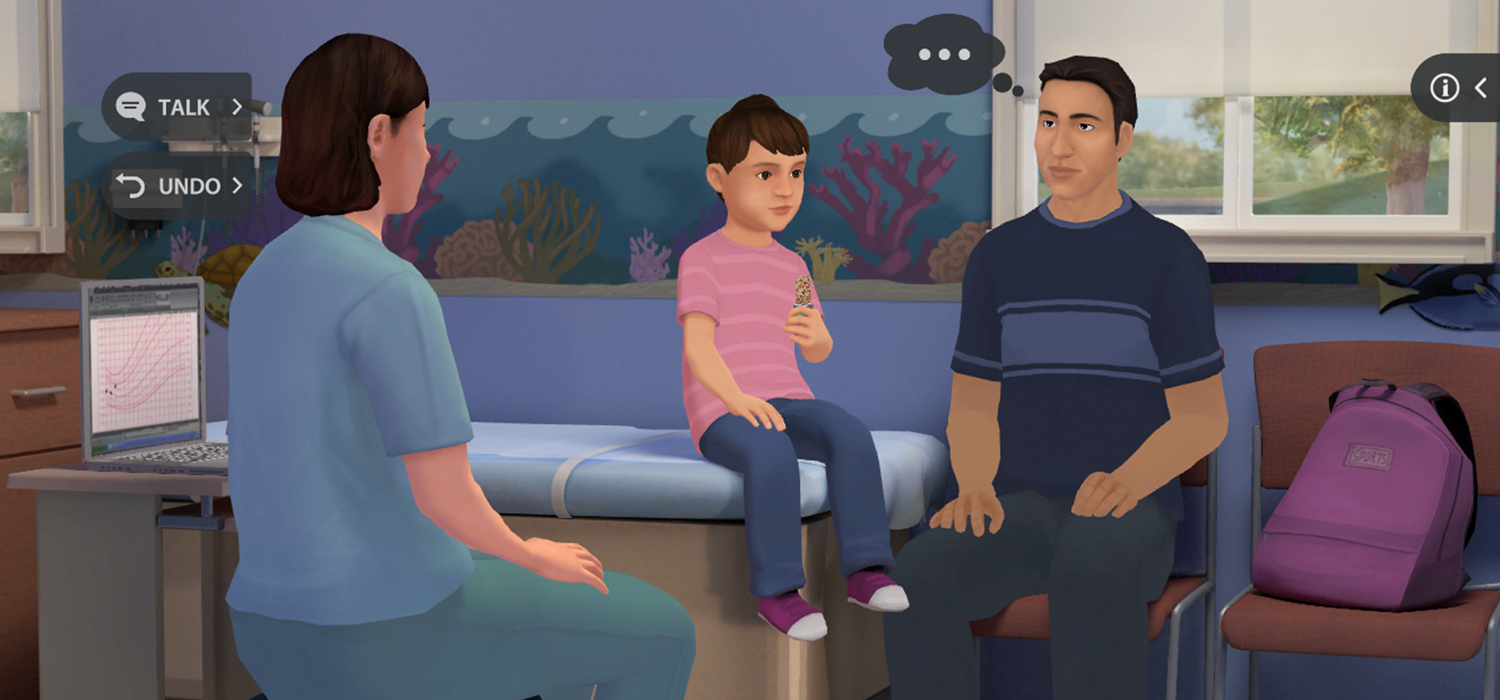Contributors: Glenn Albright, Ph.D. and Ron Goldman
Gaming has come a long way since the days of Atari. What was once viewed as simply a leisure activity has evolved to be so much more. Video gaming technology is now being used in a previously unexpected way: medical training.
Instead of defeating villains or collecting gold coins, students are using gaming technology to learn, practice, and gain confidence to help real people facing medical and mental health issues.
Kognito, an Ascend Learning health simulation company, is at the forefront of applying simulation technology in training. Kognito has helped organizations like National Healthcareer Association (NHA) give healthcare students and professionals access to highly interactive and individualized training from virtually anywhere, using their computers or mobile devices.
How simulation is being used in healthcare training
Kognito’s virtual humans portray patients who present with behavioral health challenges such as alcohol use, opioid addiction, and suicidality. The virtual patients are programmed to act and respond just like real patients. The technology allows users to assume the role of a virtual health professional and to engage in role-playing conversations with the patient. Users receive tailored feedback immediately as they select or deselect dialogue choices, with the goal of using conversation tactics like motivational interviewing (MI) that will best help the patient. This provides training in a low-risk environment, which allows users to experiment and feel comfortable before applying these skills in real life.
In the gaming sense, dialogue is the “weapon.” Learning effective conversation tactics for different situations leads to a “win” — a win that when translated in the real world, could help improve or even save lives. These simulated conversations with emotionally responsive virtual patients have tremendous success, especially when compared to traditional textbook learning or even to live role-playing with peers
or instructors.
“It’s amazing, and not surprising, that people find it easier to talk to virtual humans,” says Dr. Glenn Albright, Kognito co-founder and director of research. “[People] don’t get as anxious as when they role play face-to-face with instructors or peers. Virtual humans are easier to talk to; you feel less threatened and you feel like you’re not going to be judged, so you are more yourself.”
Some concepts can be learned from textbooks, but mastering the art of conversation is best accomplished through practice. As healthcare institutions focus more on patient-provider relationships, simulation training can be a game-changing tool to help train current and future healthcare professionals.
“People learn best through practice. None of us learned how to ride a bike from a movie. We all had to get on a bike,” says Ron Goldman, Kognito co-founder and chief executive officer. “Even though we can all agree that’s the best way of learning — to learn by doing — the training industry is still dominated by non-interactive, non-simulation training.”
Antoinette Schoenthaler, Ed.D., FAACH, a professor at NYU School of Medicine, echoes Goldman’s statement that learning through repeated practice is more effective than traditional methods. “I’ve been doing MI and communication skills training for a really long time, and what we’ve learned is that a one-time, workshop-based opportunity where there’s no real interaction with patients is not effective,” she says. “What I find fascinating from the Kognito model is that this gives [students] opportunities to repeatedly practice effective communication skills and learn from their mistakes in a safe environment.”1
“What I find fascinating from the Kognito model is that this gives [students] opportunities to repeatedly practice effective communication skills and learn from their mistakes in a safe environment.”
Simulation training:the way toward patient-centered care?
Patient-centered care is becoming increasingly important across all healthcare venues. According to Goldman, the days of lecturing patients are over. Collaboration with and active participation from patients, their families, and the healthcare team are essential to providing exceptional care. As healthcare organizations work toward a team-based or patient-centered care model, simulation training can be a powerful tool.
Goldman hopes that the rapid adoption of simulation training in sectors like healthcare is the start of a transition to a time when interactivity plays a more primary role in education. Simulation training has the potential to make a huge difference in healthcare professionals’ conversation skills and confidence — keys toward more successful patient-centered care. When healthcare workers can more effectively communicate and collaborate with patients, strides can be made to improve their social, emotional and physical well-being.
Can a virtual patient cause real behavior change?
An astounding 65 million Americans will experience a mental health or substance use disorder in their lifetime. This raises their risk of disease and mortality, and increases healthcare costs.2
Fortunately, there are clinical approaches to help healthcare professionals screen more patients for substance use or mental health disorders, which can lead to early detection and lifesaving, timely interventions. According to a survey of nearly 700 healthcare professionals:
- 57% don’t feel adequately prepared to screen patients, or to provide their patients with information about the impact of substance use and mental health disorders;3
- 64% don’t feel adequately prepared to use MI techniques to enhance their patients’ motivation to change their behaviors or to seek help;3
- 62% don’t feel adequately prepared to collaborate with their patients to create an action plan.3
It’s clear that there’s a lot to gain from more effective screening and an opportunity for healthcare professionals to improve their conversation and MI skills to better serve patients.
Data from providers who have completed Kognito simulations show statistically significant improvement in provider skills.
In the months following use of simulation, health professionals reported a 20% average increase in the number of patients they screened, engaged in brief intervention and referred to follow-up care.4 In addition, it’s also shown to:
- Be cost effective
Studies have shown that investing in Screening, Brief Intervention, and Referral to Treatment (SBIRT) training for care teams can result in healthcare cost savings ranging from $3.91 to $5.60 for each dollar spent on implementation.5 - Save time
Goldman says that one of the key ways Kognito measures ROI is a reduction in not only cost, but time, compared to other training modalities such as workshops. - Deliver and scale effective training
Because simulation is easily accessible online, students are able to complete training in their own time, without needing an instructor, manager or peer.
“I was cynical initially about the role that this kind of technology could play,” says Adina Kalet, MD, MPH, professor of medicine and surgery at NYU School of Medicine. “I think it has a very, very important role in helping us scale our interventions with patients since what we actually do requires four hours of direct interaction...I think most people don’t have that kind of time or resources and this is a way of scaling up the practice parts of what we know works to help people get empowered.”6
These results are promising, and suggest a future where simulation plays a greater role in training and in continuing education.
Looking forward: what to expect in the future of simulation training
Simulation training may seem like something from the future, but it’s here now, quickly being adopted across healthcare because of its success. Technology continues to evolve at a rapid pace…so what does the future of simulation training look like?
Goldman anticipates better integration of artificial intelligence (AI) in simulation, saying that the future of virtual patients will be even more life-like and will have the capability to understand subtle details, such as the intonation of your voice: "AI and machine learning are going to allow all of us in this industry to increase the value that we can derive from simulation being able to better mimic real life,” Goldman predicts.
In addition to better technology, there’s also a likelihood for larger reach. Dr. Albright is excited about the future applications of simulation training as it expands into more areas. “Once you experience this technology, you can think about how it can be applied to help so many people,” he says. “There are so many important areas where we can make a difference in peoples’ lives.” Dr. Albright noted examples such as caretakers dealing with the aging population, or with parents of children with autism.
As technology continues to advance and adoption spreads, the possibilities are limitless. Simulation training has the potential to help transform the way we learn and lead to better outcomes for healthcare educators, healthcare providers and ultimately, for the patients they serve.
In this game, everyone wins.
For more information about Kognito’s simulation training, visit Kognito.com.
References:
1 Kognito. (2019, January 15). Antoinette Schoenthaler, EdD, FAACH - Center for Healthful Behavior Change - NYU School of Medicine [video file]. Retrieved from https://youtu.be/294u3Q0EPYw.
2 Substance Abuse and Mental Health Services Administration. (2018). Key substance use and mental health indicators in the United States: Results from the 2017 National Survey on Drug Use and Health (HHS Publication No. SMA 18-5068, NSDUH Series H-53). Rockville, MD: Center for Behavioral Health Statistics and Quality, Substance Abuse and Mental Health Services Administration. Retrieved from https://www.samhsa.gov/data/.
3 Finnell, DS., Albright, G. (2019). Are Healthcare Professionals Ready to Address Patients’ Substance Use and Mental Health Disorders?. Retrieved from https://go.kognito.com/rs/143-HCJ-270/images/Are-Healthcare-Professionals-Ready-to-Address-Substance-Use-Mental-Health.pdf.
4 “Kognito. (2018, November 29) Kognito’s Simulations on Conducting Mental Health and Substance Use Screening and Brief Intervention [video file]. retrieved from https://youtu.be/qo9sxUjZV40.
5 Koetting, C. Freed, P. (2016, August 1). Educating Undergraduate Psychiatric Mental Health Nursing Students in Screening, Brief Intervention, Referral to Treatment (SBIRT) Using an Online, Interactive Simulation. Archives of Psychiatric Nursing, Volume 31, Issue 3, 241-247. Retrieved from https://www.psychiatricnursing.org/article/S0883-9417(16)30150-9/abstract.
6 Kognito. (2019, January 15). Adina Kalet, MD, MPH of NYU School of Medicine [video file]. Retrieved from https://youtu.be/CGh6qwdUl3A.




